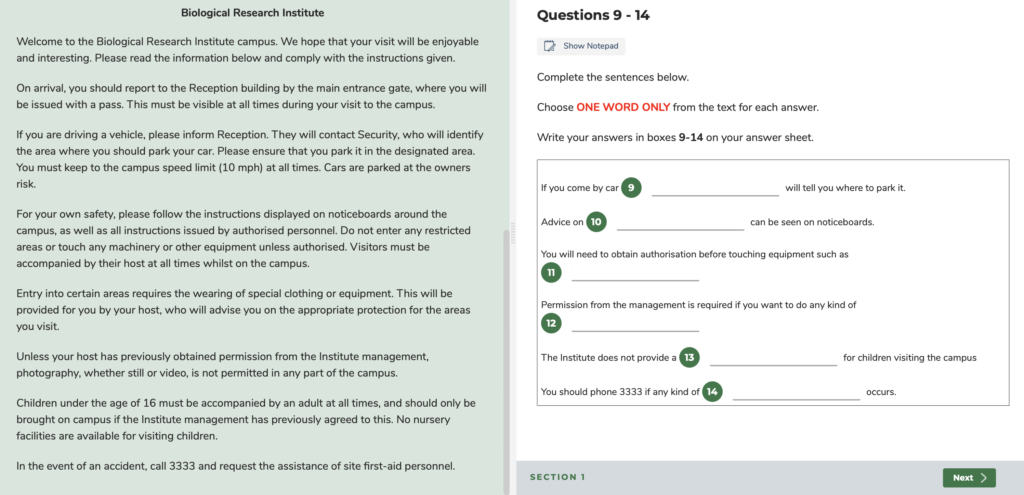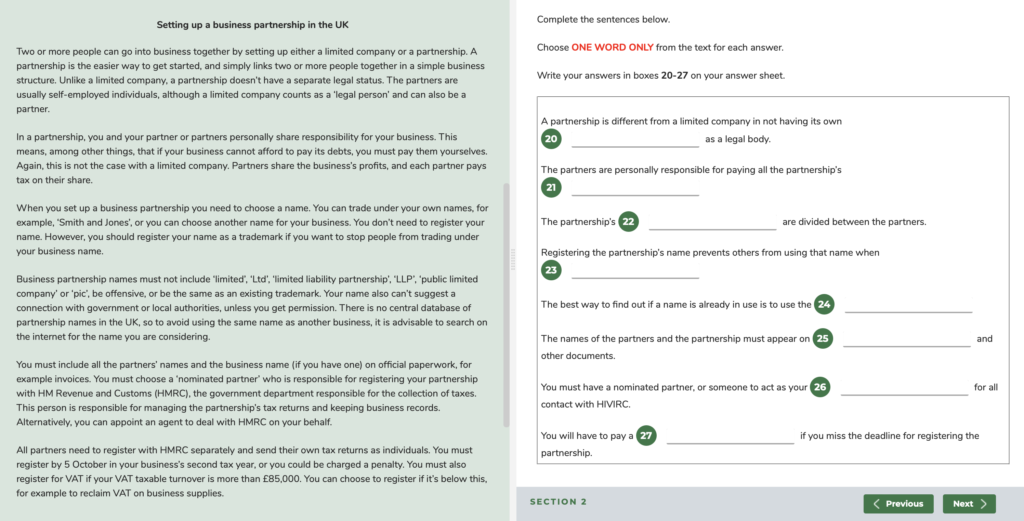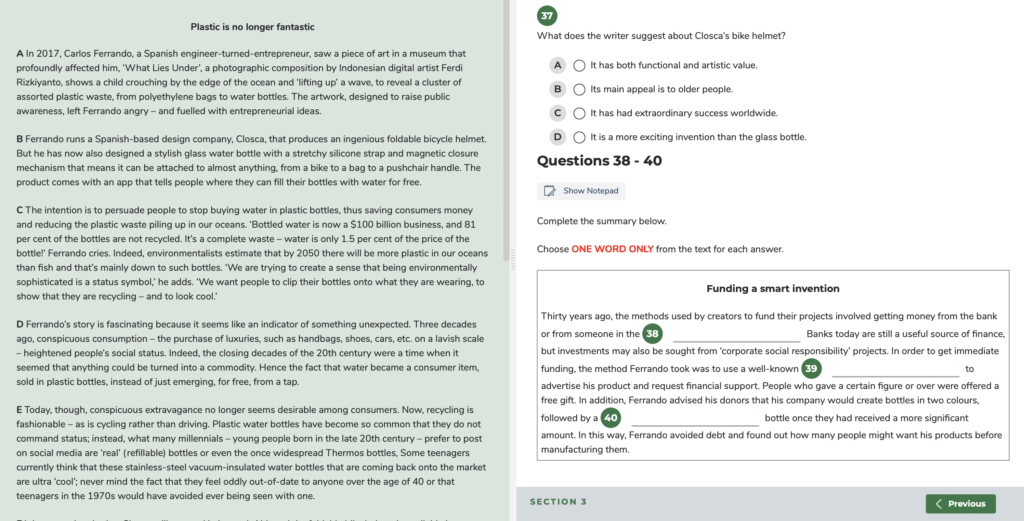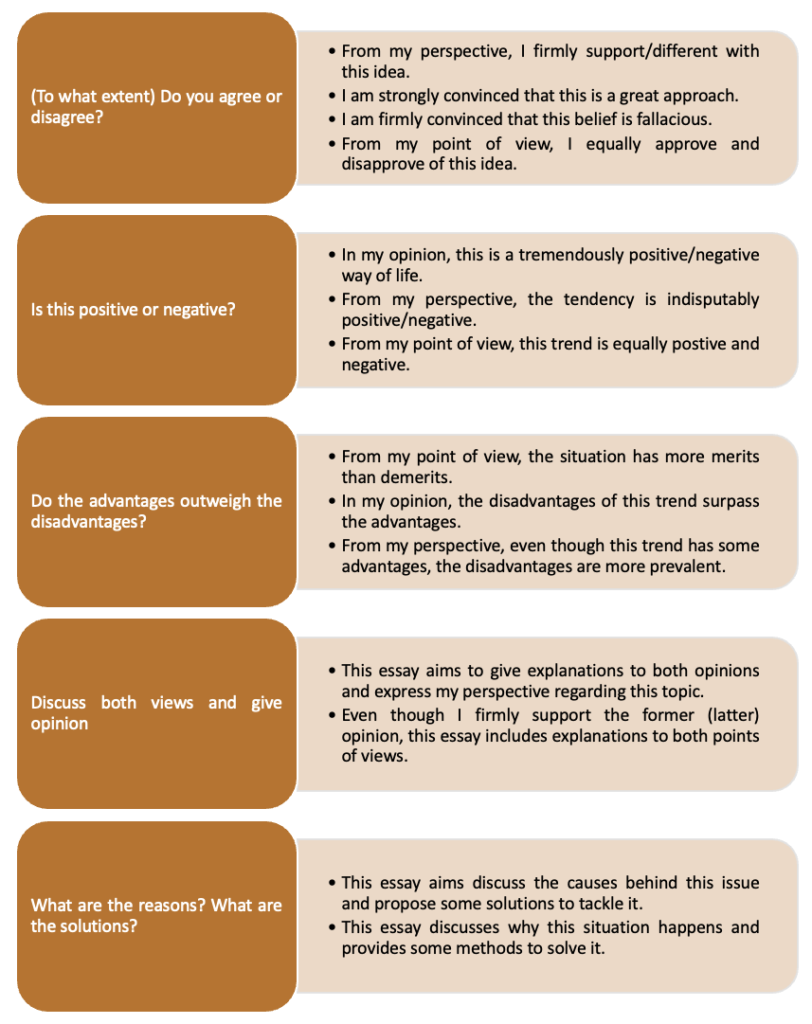Enjoy some of the goodness of Everything IELTS - The Comprehensive Guide to IELTS
Choose the skill and read parts of the materials
The official Everything IELTS – The Comprehensive Guide includes 18+ lessons, 16+ topics, and 80+ quizzes and practice tests.
Every piece of content below comes with exclusive quizzes and practice tests.
Fill in the gaps (FITG)
Overview about FITG
This is a Detailing form of question. FITG questions in the IELTS General Training Reading exam require you to complete a passage with the missing words, in other words, the missing pieces of information. The words are usually taken from the text to form sentences that make sense. You can write the answers in all capitals or lowercase.
There are four key elements of FITGs.
- The missing words are always keywords.
- Most possible answers: nouns, verbs, adjectives, names, and numbers.
- Less possible answers: adverbs.
- Impossible answers: pronouns, prepositions, and conjunctions.
FITGs can appear in all three parts of the IELTS GT Reading test at varying levels of difficulty.



In IELTS Academic Reading, there are different types of FITGs, but in IELTS GT Reading, only the traditional type is used, as shown in the examples.
Tips
- Apply all the Reading rules.
- DO NOT exceed the number of words allowed for each gap. If two words are allowed, you can write one word or two words, but not three words. If you write three words, the answer is considered incorrect.
- Put the same words that you see in the texts in the gaps. No change is needed. The grammar in the question always matches the grammar of the correct answer (correct word). For example, if you see “colors” in the text and determine that “colors” is the correct answer, put the exact word (“colors”) in the gap. There is no need to think about the grammar.
- Understanding what type of word (noun or verb, for example) is needed for the gap can help you eliminate incorrect answers, but it is not absolutely required. For example, if you’re debating between “colors” (a noun) and “beautiful” (an adjective) for the answer to a gap, but the gap requires a noun, “beautiful” is out. As a result, you can rule out “beautiful” as a possible answer.
- Depending on the context of the question, you can eliminate the incorrect words. As a result, even if you do not understand grammar, you can still find correct answers.
- Both American spellings and British spellings are accepted.
- Always check your spelling after finishing the questions. Correct words with wrong spelling are still considered wrong answers.
Step-by-step strategy
Step 0: Look at the questions and identify the type of questions.
Step 1: Read and memorize the first TWO questions.
- Highlight keywords but keep in mind that these words may not appear in the text, instead, they may be replaced with synonyms.
- Memorize the meanings of the questions.
Step 2: Read the text and find the answer to the first question.
- Start reading from the beginning or from what is left of the text. If these are the first questions of the first group of questions, read from the beginning of the text. If these are the first questions of a second or third group of questions, continue reading from where you left off.
- In most cases, the first answer will come first, followed by the second. If the second answer comes first, one of these two things could have happened: you’ve missed the first answer, or the answer is coming right after this. In this case, you must return to look for the first answer. If you still cannot find it, it means you will not be able to find it there. So, you should keep reading.
- Remember to mark the “location” of each answer, that is, which line and paragraph the answer belongs to.
Step 3: Reread the unanswered question and read the third question.
- If you have already found the first answer, you should go back and reread the second question to refresh your memory. If you have found the second answer, you should go back and read the first question.
- Highlight keywords and the meaning of the third question. Prepare for synonyms.
Step 4: Continue reading where you left off and mark the “locations” of answers.
Step 5: Reread unanswered questions and read the next question after one question is done, until the last question.
Step 6: Check spelling and word limit.
Fill in the gaps (FITG) - Traditional
Overview
“Fill in the gaps” (FITG) questions require you to listen carefully to the recordings and find words to fill in the gaps. This means you must find missing information to complete the sentences or phrases.
There is a limit to the number of allowed words, which is mentioned in the instructions for each part. The missing words are keywords of the sentences/phrases and the recordings.
- Most possible types of answers: nouns (including names), verbs, adjectives, and numbers.
- Less possible types of answers: adverbs, and pronouns.
- Impossible types of answers: prepositions, and conjunctions.
- Special symbols that come with numbers are considered a part of the numbers. For example, 20% is considered one number.
- You can write in all capitalized letters or lowercase letters.
This type appears throughout 4 parts of the Listening exam at different difficulty levels.
The traditional FITG
In this variety, you need to listen and pick words to complete the sentences and phrases. It can come in different ways, including Note and Form Completion, and Sentence completion.


Tips
- Answers appear in a sequential order, from the first to the last.
- Keep the same form of the words taken from the recordings.
- There will be at least one number if numbers are allowed.
- There will be at least one spelling question in which names are spelled out.
- Nouns and adjectives are most likely the answers. Verbs are also possible but less likely.
- Answers are normally common words. No academic words.
- Pay more attention to words before the missing information.
- The answer might be initiated by one speaker and confirmed by another speaker. So, if the information appears in a question by one person, the correct answer is confirmed in the response of another person.
Step-by-step strategy
Step 1: Analyze the questions.
- Pay more attention to words before the missing information because they indicate when the information will likely be mentioned in the text.
- Prepare for common synonyms of words (words with the same meaning).
- Highlight words if you feel more comfortable. However, it is not a must. (More in Common Mistakes)
- Guess the types of words that might fit the missing information based on grammar.
Step 2: Follow the flow of information
- Match the information that you hear and the information in the questions.
- Trace and mark the information as you hear.
- Ignore the information you already heard or missed regardless of order. Sometimes the order of information changes, e.g., ‘washing then boiling’ in the recording becomes “boiling after washing” in the question. (More in Common Mistakes.)
- The sequential order could be reversed a little. For example, sometimes question 4 comes before question 3 but the gap between them is very small, normally just right after question 4, you will hear question 3.
- Taking notes can help you follow the information flow better. (See Notetaking.)
Step 3: Answer the question either along with listening or after taking notes
- If you take notes when listening, you can refer to your notes later to answer the questions based on the information you have in your notes.
- If you don’t take notes, answer the questions right after you catch the information. Skip the questions you don’t catch the answer and move on to the next one.
Step 4: Check spelling and word limit
- Both American and British spellings are accepted.
- If the spelling is wrong, the answer is wrong.
- If the answer contains more words than is allowed, the answer is wrong.
- Sometimes, you can switch between singular and plural forms of words, depending on the grammar of the question sentences. So, the best option is to keep the same form you hear in the recording.
Letter of Complaint
There are 5 common types of letters. You may get a mix of two types in one letter. From this session, you will learn these types and how to write them properly to get the most out of TA and CC. You will also be provided with a vocabulary bank for each type, along with useful structures that will help you boost your LR and GRA scores.
You should keep in mind that these vocabulary banks and structures are for reference purposes. They are presented on a level basis, ranging from A1 to C2. They are not to encourage you to copy and memorize. You are advised to create your own vocabulary banks and structures so you can use them in your actual exam without being marked as a memorized answer by examiners.
If you are subscribed to the Premium package, every written exercise will be checked, corrected, and evaluated.
Let’s start!
Letter of Complaint
What is a letter of complaint?
Something went wrong and you want to complain to the organizations/people in charge, so you write a letter of complaint, such as
- You shopped at a well-known brand’s store and the shop assistant was very rude to you and (of course) you were not happy, so now you write a letter to the manager of the store to complain;
- A co-worker repeatedly joked about your accent, and it made you very uncomfortable, so you decided to write a letter to the Human Resources Department to complain.
Possible writing styles: Formal and semi-formal. In general, informal language is not used in Letters of Complaint.
Example
Writing task 1 The construction of the house next to your house often continues until late at night, and it affects you and your family. Write at least 150 words. |
How to write it?
Opening
It depends on the topic, but the Opening of a letter of complaint often includes 2 parts.
- Self-introduction: people will not take you and your complaint seriously if they do not know who you are. A brief introduction about yourself can help establish your story later. However, in case the recipient is more likely to know you, a self-introduction isn’t necessary.
- Aim of the letter: express briefly what the letter is about to give readers a heads-up and to help your story more convincing. You can paraphrase the scenario in this part.
Here are some suggestions to express the aim of a letter of complaint.
- I am (I’m) writing this letter to complain about [something].
E.g., I am writing this letter to complain about the problems that the construction of the house adjacent to mine is causing me and my family.
- I am (I’m) writing this letter to express/convey my dissatisfaction with/discontent about[1]/concern about/frustration regarding + [something].
E.g., I am writing this letter to express my discontent about the problems that the construction of the house adjacent to mine is causing me and my family.
- I am (I’m) writing this letter in regard to/regarding [something].
E.g., I am writing this letter in regard to the problems that the construction of the house adjacent to mine is causing me.
- I feel compelled to bring to your attention that [something] was unsatisfactory/disappointing[2].
E.g., I feel compelled to bring to your attention that the food served at the dinner yesterday was disappointing.
- I regret to inform you that [something] did not meet my expectations.
E.g., I regret to inform you that the decorations of the event yesterday did not meet my expectations.
- I have encountered a problem with [something], and I would like to bring it to your attention.
E.g., I have encountered a problem with the receptionist’s behavior, and I would like to bring it to your attention.
Main content
It is important to use appropriate verb tenses when elaborating the story. The Grammatical Range and Accuracy criterion matters the most in this part, so make sure you use a wide range of structures correctly and naturally.
- Explain the situation and the problems: Past tenses, specifically past simple, past continuous, past perfect, and present perfect.
- Propose solutions: Present tense, specifically present simple, and future simple tense.
Depending on the context, you can use other structures to boost your GRA score.
Useful grammar structures and vocabulary for letters of complaint.
| Grammar points and phrases | Usage | Example |
| be + always [doing something] | Express your discontent about a situation happening repeatedly. In a letter of complaint, this structure is mainly used to describe a past situation. | The teacher was always talking on the phone during the lessons. (The teacher repeatedly talked on the phone during the lessons, and you were not happy with that.) |
| have/has + always been [doing something] | Express a situation that has been happening for some time and you have not been happy about it at all. This structure is an extension of “be + always [doing something]”, and it emphasizes the duration of the action and your discontent about the situation. It is very useful to express your complaint, especially in describing the situation without sounding like you are “whining”. It helps your complaint sound more reasonable and valid. | This is not what I was promised when I purchased the membership from your premises. |
| I believe there was a mistake/an oversight in [something]. | Say what was wrong in detail. | I believe there was a mistake in our booking. |
| I am dissatisfied with the level of [something] I received in relation to [something]. | I am dissatisfied with the level of customer service I received in relation to the incident that happened to me. | |
| This is not what I was promised when I [did something]. | This is not what I was promised when I purchased the membership from your premise. | |
| I find it unacceptable that [description of the situation]. | I find it unacceptable that the food was allowed to be served uncooked. | |
| I expect [something]. | Express expectation | I expect a response to my concern from you soon. |
| I would like to [do something]. | Propose a reasonable solution politely | I would like to request you to send a warning to Mr. White, so he is aware of his disturbing behaviors. |
| I would appreciate it if you could address the issue with [someone] about [something]. | I would appreciate it if you could address the issue with Mr. White about his behaviors. | |
| I would like [something] to be rectified. | I would like the issue to be rectified. |
The Structure of the Introduction
In the Introduction, you should introduce the examiners to the topic and establish their “expectations.” Examiners should have a clear understanding of what to expect from your essay after reading the Introduction.
The introduction is often overlooked in IELTS essays. However, the introduction determines how you will build your essay in the following sections. If you make changes to the Introduction, you must make changes to the rest of the essay as well. A good essay begins with a clear introduction.
A clear introduction must include the statement(s) and the core idea.

The statement(s)
You must paraphrase all the statements in the task in the statement section. It is recommended that you use different grammatical structures and synonyms of keywords that are in the original sentences. You are expected to have studied the Paraphrasing Technique before reading this part.
Attention: If you copy the whole given statements to your essay, it is considered “not having the statements”.
A lead is optional before the statements. The lead is a statement that introduces the subject to the examiners. When introducing a lead into your work, though, you must exercise caution. It frequently causes unnecessary information and wastes time. It may also cause you to repeat essay keywords. An example of a lead sentence is, “XYZ has become a contentious issue.”
The core idea
The core idea is the main idea of the whole essay. Every essay has only one core idea and it must be presented clearly in the introduction, after the statements. In other words, you are saying what you will do in this essay.
There are 2 options for presenting the core idea, depending on the kind of questions in the task.
- A direct answer to the question: If it is a yes/no question or a choosing question, you must give a clear and direct answer to state your opinion.
- The aim of the essay: Any other kinds of questions could be answered with “the aim” of the essay or a direct answer. When giving a direct answer in this case, pay attention to the consistency of essay ideas. If you change the core idea in the introduction, you will need to change the body paragraphs as well, and vice versa. If you decide to change the idea or add new ideas while writing the body paragraphs, you must also change the introduction.
Note: There must be consistency in ideas throughout the essay, starting from the core idea of the essay. Do not go beyond what is mentioned in the core idea.
Here are some suggestions to start presenting the core idea of the essay.


Example 1:
In many countries, an increase in crime has been blamed on violent images on television and in computer and video games. To what extent do you agree or disagree?
In many countries, the violent visual content on TV and in video games has been perceived as the reason for the rise in crime rates. From my perspective, I profoundly agree with this statement.
Example 2:
In many countries, young people are unemployed despite being educated. What are the reasons? What should be done about it?
In many countries, young generations are unemployed even though they are well educated. This essay aims to discuss the most striking reason behind this situation and propose a solution to tackle it.
Three rules for a good IELTS Speaking Performance
Lorem ipsum dolor sit amet, consectetur adipiscing elit. Ut elit tellus, luctus nec ullamcorper mattis, pulvinar dapibus leo.
Rule #1: Be straightforward.
After the examiner has given you the question, directly answer it. You don’t have to “beat around the bush”. By directly giving your answer, you show the examiner that:
- you understood the question and what needs to be done;
- you have the English capacity to answer the question without having to think about related vocabulary, grammar, or pronunciation.
After you have given a direct answer, you can explain it by adding more information.
You don’t have to answer the questions right at the second the examiner finishes asking. You can take a deep breath and then answer. But pausing too long may affect your score. See more in Common Mistakes.
Rule #2: Use the same grammar to answer the question.
When you give a direct answer, you should use the same grammar as the question in your answer. By doing this, you show the examiner that:
- you recognize the grammar and what needs to be done to answer the question properly;
- you can use this type of grammar correctly.
Example:
Question: Have you ever tried foreign food? (Present perfect tense, a yes/no question)
Answer: Yes, I have. (A direct answer with the same grammar) I am a curious person by nature, so I always want to try different things, including languages, cultures, traditions, and, of course, food. My favorite foreign cuisine is Chinese. (Explanation and example)
Rule #3: Always elaborate on the answers.
Elaboration comes in many ways. It can be an explanation of your answer or an example of your answer.
The idea is to never give a one-word answer, such as yes or no, or an answer that is too short, such as ‘I am a big fan of romantic movies.’

